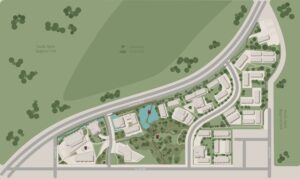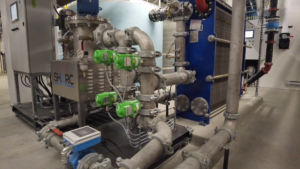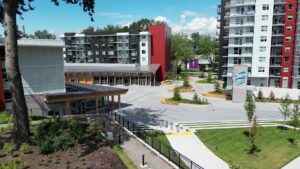SHARC Energy Systems’ Closed Loop SWEE Puts Waste Heat to Work

Projects Sponsor
By keeping energy circling the neighbourhood, instead of just circling the drain, SHARC Energy Systems is poised to throw conventional energy systems for a loop.
When the plans for Musqueam Capital Corporation’s (MCC) new 22-acre development in Vancouver, leləm̓ Village, were being drawn up, it was understood that the development and its energy system would have to be district energy compatible, cost effective, and designed for future needs. It was also essential that the system, like other elements of the project’s design, be true to Musqueam’s core values of being in harmony with nature.

In keeping with all this, the MCC team, working with the original engineering firm, soon began to visualise the impact that an energy sharing loop would have on the project’s energy requirements. Unfortunately, change sometimes being as hard a buy as it is a sell, a four-year battle against the constraints of conventional engineering followed. It was only after their original engineering firm was replaced and MCC enlisted SHARC Energy Systems that things began to go swimmingly.
Options were researched and presented, and MCC decided to go all in on a first-of-its-kind passive energy loop, connecting all seventeen planned buildings — totalling 1.2 million sq ft of residential space — and truly breaking some ground.

The state-of-the-art SHARC SWEE system that the project utilises is based on a passive energy loop. That means it’s designed around the common-sense notion that when energy leaves a building, that’s a resource squandered. A passive loop takes a “waste not, want not” approach to providing space conditioning and hot water.

Conventional construction techniques mean that billions of gallons of energy-rich hot water go straight into the sewers at commercial, industrial, and residential sites each day. That’s a lot of thermal energy we call wastewater going down the drain. By keeping that energy in the loop and then sharing it within the development, the SHARC SWEE system promised to meet the project’s needs, while aligning with MCC’s ethos. However, seeing that promise fulfilled wasn’t always easy.
New technology is often met with scepticism and sometimes outright hostility and that made aspects of the leləm̓ project a challenge. Doing the work to convince people accustomed to conventional engineering design that an energy sharing system was feasible, in fact preferable, was fundamental to the project’s success.
Naturally, the project’s ownership group needed reassurance that the system was future proof, that financing it was a sound investment. Local CleanBC grant writers too had to be convinced that energy sharing was an effective means of reducing energy use. A method of measuring and verifying the quantity of energy reuse was developed for the project and this helped make the case to the concerned.
A civil survey was done to confirm underground services could be installed. Even once the available grant funding had been secured and buy-in at all levels had been achieved, finding mechanical contractors willing and able to install the vastly different mechanical system was a challenge, as was burying the necessary extra services.
Ultimately all this perseverance paid off and the district loop piping was installed underground while the road system was being done, providing a hydronic connection for all of the community’s buildings. The loop was complete in time for the commissioning of the first of the buildings and the development has grown from there.
The main energy plant room that houses the SHARC SWEE system was installed with a connection to the main sewer line. It’s designed so that energy is shared within each building first. Then, if there is an energy imbalance, the central loop allows for thermal energy to flow either to the loop or from the loop. Heat in the winter is recovered and reused. Waste heat from air conditioning in the suites is reused to produce domestic hot water.

Edge Consultants were brought in to do the energy and CO2 reduction analysis that showed a very significant reduction in energy usage and CO2 production. By having almost zero wasted energy the leləm̓ project has proven to be a financial and environmental winner. Indeed, SHARC have determined in the first 18 months of operation that approximately 80% of the energy requirements are met with recycled energy within the development.
By keeping energy circling the neighbourhood, instead of just circling the drain, SHARC Energy Systems is poised to throw conventional energy systems for a loop.













